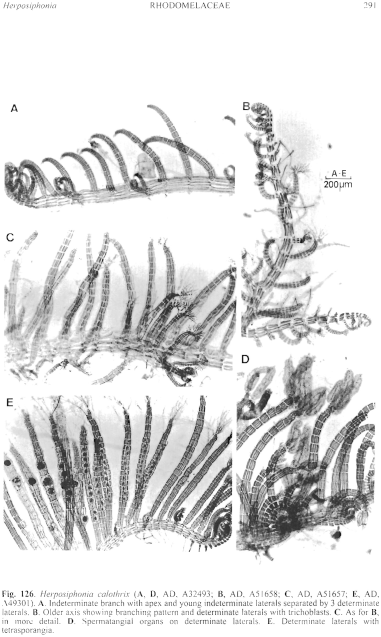|
|
|
|
|
|||||||||||
|
Electronic Flora of South Australia Species Fact Sheet
Phylum Rhodophyta – Family Rhodomelaceae – Tribe Herposiphonieae
Synonyms
Polysiphonia calothrix Harvey 1855a: 541; 1862a: pl. 185C; 1863, synop.: xxi. J. Agardh 1863: 942. Askenasy 1888: 50, pl. 10 figs 14–17. Kützing 1864: 13, pl. 38f, g. Sonder 1880: 35.
Lophosiphonia? calothrix (Harvey) De Toni 1903: 1071. Lucas 1909: 45. Lucas & Perrin 1947: 294. May 1965: 380; 1970: 82. Millar & Kraft 1993: 56.
Thallus (Fig. 126A, B) forming low mats, with extensive prostrate axes bearing simple, erect, 1–2 mm high, determinate laterals on 3 consecutive segments (Fig. 126A), separated by short indeterminate laterals, some developing into lateral axes (Fig. 126B) adherent to the substrate. Attachment by rhizoids; epilithic or epiphytic on Corallina and Codium. Structure. Apices of indeterminate axes dorsally revolute (Fig. 126A), apical cells hemispherical, 10–15 µm in diameter. Axes 100–220 (–250) µm in diameter, segments L/D 0.6–1 (–2), with 8–9 (–12) pericentral cells; determinate laterals (Fig. 126C) arising dorsally, 70–100 µm in diameter, segments L/D (0.6–) 1–2, with 7–8 (–9) pericentral cells. Trichoblasts near ends of determinate laterals, 0.5–1 mm long, much branched, lower cells 12–18 µm in diameter. Rhizoids cut off from ventral pericentral cells, unicellular with digitate haptera (branch ends often cut off as separate cells). Cells multinucleate; rhodoplasts discoid to elongate, then often in parallel stacks.
Reproduction: Gametophytes dioecious. Procarps with a 4-celled carpogonial branch. Cystocarps (juvenile) ovoid; pericarp arising prefertilization, 2 cells thick with small corticating cells. Spermatangial organs (Fig. 126D) replacing trichoblasts on mid to upper parts of determinate laterals, lanceoid, 100–550 µm long and 50–120 µm in diameter, with a sterile basal cell and terminal row of 2–5 sterile cells.
Tetrasporangia (Fig. 126E) in straight series in determinate laterals, one per segment, 50–75 µm in diameter, with 2–3 cover cells.
Type from King George Sound, W. Aust., on mid-tide rocks; lectotype Harvey, Alg. Aust. Exsicc. 178B (Trav. Set 337 missing in 1952).
Selected specimens: Hillary Boat Harbour, Sorrento, W. Aust., 6 m deep on reef (AIMS-NCI Q66C 2603-U, 11.iii.1989; AD, A59631). Vlaming Head, Rottnest I., W. Aust., on limpets on reef (Woelkerling, 8.ii.1978; AD, A49301). Frenchman Bay, King George Sound, W. Aust., mid eulittoral on rock (Womersley, 29.viii.1979; AD, A51657) and on Corallina, lower eulittoral (Womersley, 29.viii.1979; AD, A51658). Scott Bay (W of Fowler Bay), S. Aust., reef pools (Womersley, 27.i.1951; AD, Al 4989). Elliston, S. Aust., on Codium pomoides, shaded lower eulittoral (Womersley, 15.i.1951;
Distribution: Dirk Hartog I. and Sorrento, W. Aust., to Encounter Bay, S. Australia. Botany Bay and Long Reef, N.S.W. (May 1970, p. 82).
Taxonomic notes: AD, A14956) and on C. capitulatum, low eulittoral in shade (Woelkerling, 16.v.1968; AD, A32493). Point Westall, S. Aust., on Codium capitulatum, shaded pool (Womersley, 19.i.1951; AD, A13803). Wright I., Encounter Bay, S. Aust., lower eulittoral (Womersley, 15.iv.1978; AD, A49260).
Material from the type locality clearly shows that this species is a Herposiphonia, occurring mainly in the lower intertidal.
H. calothrix is distinct from other species in its mat-like habit with entirely prostrate indeterminate axes.
References:
AGARDH, J.G. (1863). Species Genera et Ordines Algarum. Vol. 2, Part 3, pp. 787–1291. (Gleerup: Lund.)
ASKENASY, E. (1888). Algen. In Engler, A. (Ed.), Die Forschungsreise S.M.S. Gazelle in den Jahren 1874 bis 1876. IV Th. Bot., pp. 1–58, Plates 1–12. (Mittler: Berlin.)
DE TONI, G.B. (1903). Sylloge Algarum omnium hucusque Cognitarum. Vol. 4. Florideae. Sect. 3. pp. 775–1521 + 1523–1525. (Padua.)
HARVEY, W.H. (1855a). Some account of the marine botany of the colony of Western Australia. Trans. R. Jr. Acad. 22, 525–566.
HARVEY, W.H. (1862a). Phycologia Australica. Vol. 4, Plates 181–240. (Reeve: London.)
HARVEY, W.H. (1863). Phycologia Australica. Vol. 5, Plates 241–300, synop., pp. i-lxxiii. (Reeve: London.)
KÜTZING, F.T. (1864). Tabulae Phycologicae. Vol. 14. (Nordhausen.)
LUCAS, A.H.S. & PERRIN, F. (1947). The Seaweeds of South Australia. Part 2. The Red Seaweeds. (Govt Printer: Adelaide.)
LUCAS, A.H.S. (1909). Revised list of the Fucoideae and Florideae of Australia. Proc. Linn. Soc. N.S.W. 34, 9–60.
MAY, V. (1965). A census and key to the species of Rhodophyceae (red algae) recorded from Australia. Contr. N.S. W. Natl Herb. 3, 349–429.
MAY, V. (1970). New or interesting algal records from Australia. Contr. IV.S.W. Nati Herb. 4, 79–83.
MILLAR, A.J.K. & KRAFT, G.T. (1993). Catalogue of marine and freshwater Red Algae (Rhodophyta) of New South Wales, including Lord Howe Island, South-western Pacific. Aust. Syst. Bot. 6, 1–90.
SONDER, O.W. (1880). In Mueller, F., Fragmenta Phytographiae Australiae. Supplementum ad volumen undecinum: Algae Australianae hactenus cognitae, pp. 1–42, 105–107. (Melbourne.)
The Marine Benthic Flora of Southern Australia Part IIID complete list of references.
Publication:
Womersley, H.B.S. (24 February, 2003)
The Marine Benthic Flora of Southern Australia
Rhodophyta. Part IIID. Ceramiales – Delesseriaceae, Sarcomeniaceae, Rhodomelaceae
Reproduced with permission from The Marine Benthic Flora of Southern Australia Part IIID 2003, by H.B.S. Womersley. Australian Biological Resources Study, Canberra. Copyright Commonwealth of Australia.
Illustration in Womersley Part IIIA, 2003: FIG. 126.

Figure 126 enlarge
Fig. 126. Herposiphonia calothrix (A, D, AD, A32493; B, AD, A51658; C, AD, A51657; E, AD, A49301). A. Indeterminate branch with apex and young indeterminate laterals separated by 3 determinate laterals. B. Older axis showing branching pattern and determinate laterals with trichoblasts. C. As for B, in more detail. D. Spermatangial organs on determinate laterals. E. Determinate laterals with tetrasporangia.

|
Email Contact: State Herbarium of South Australia |

|